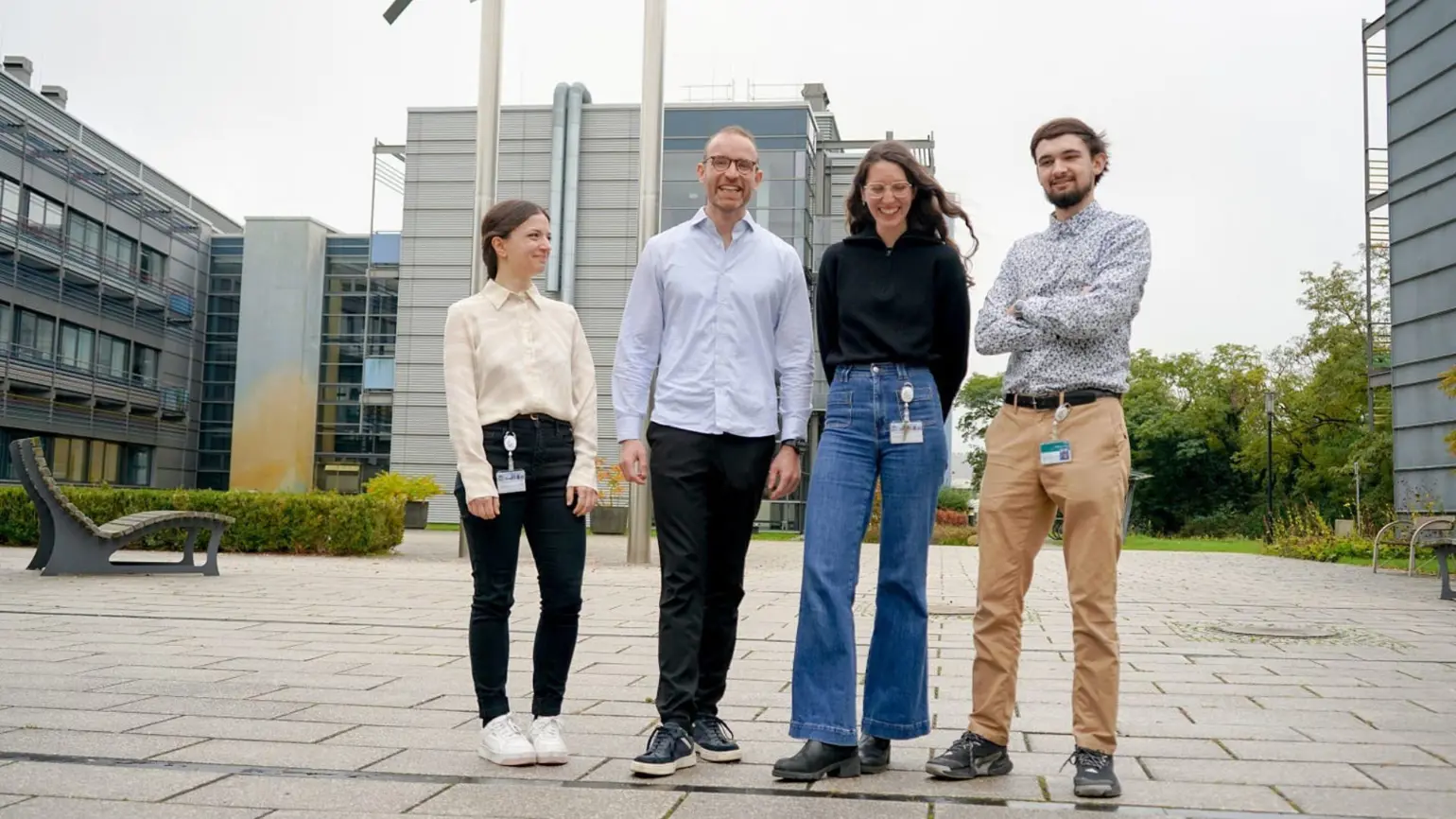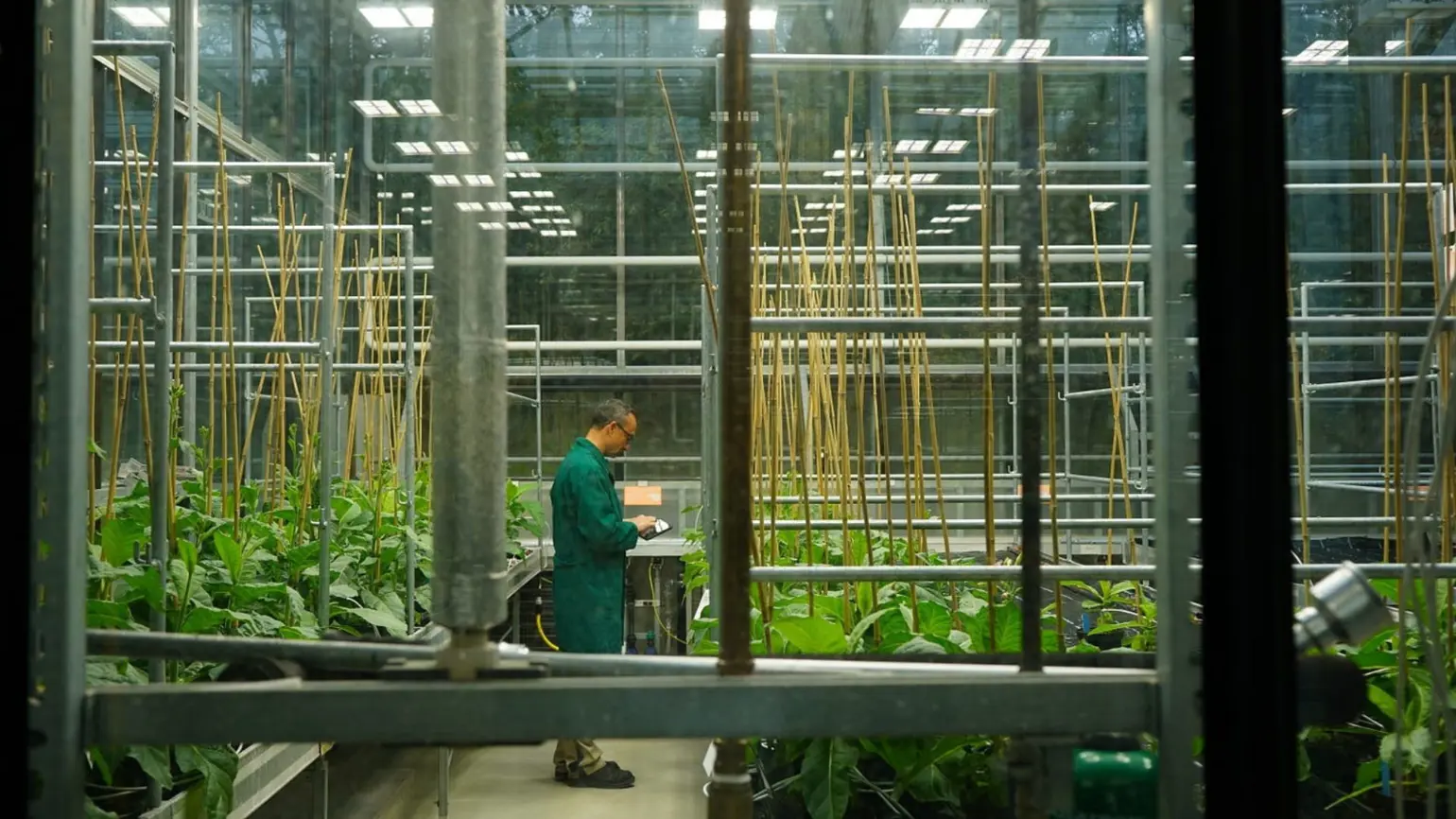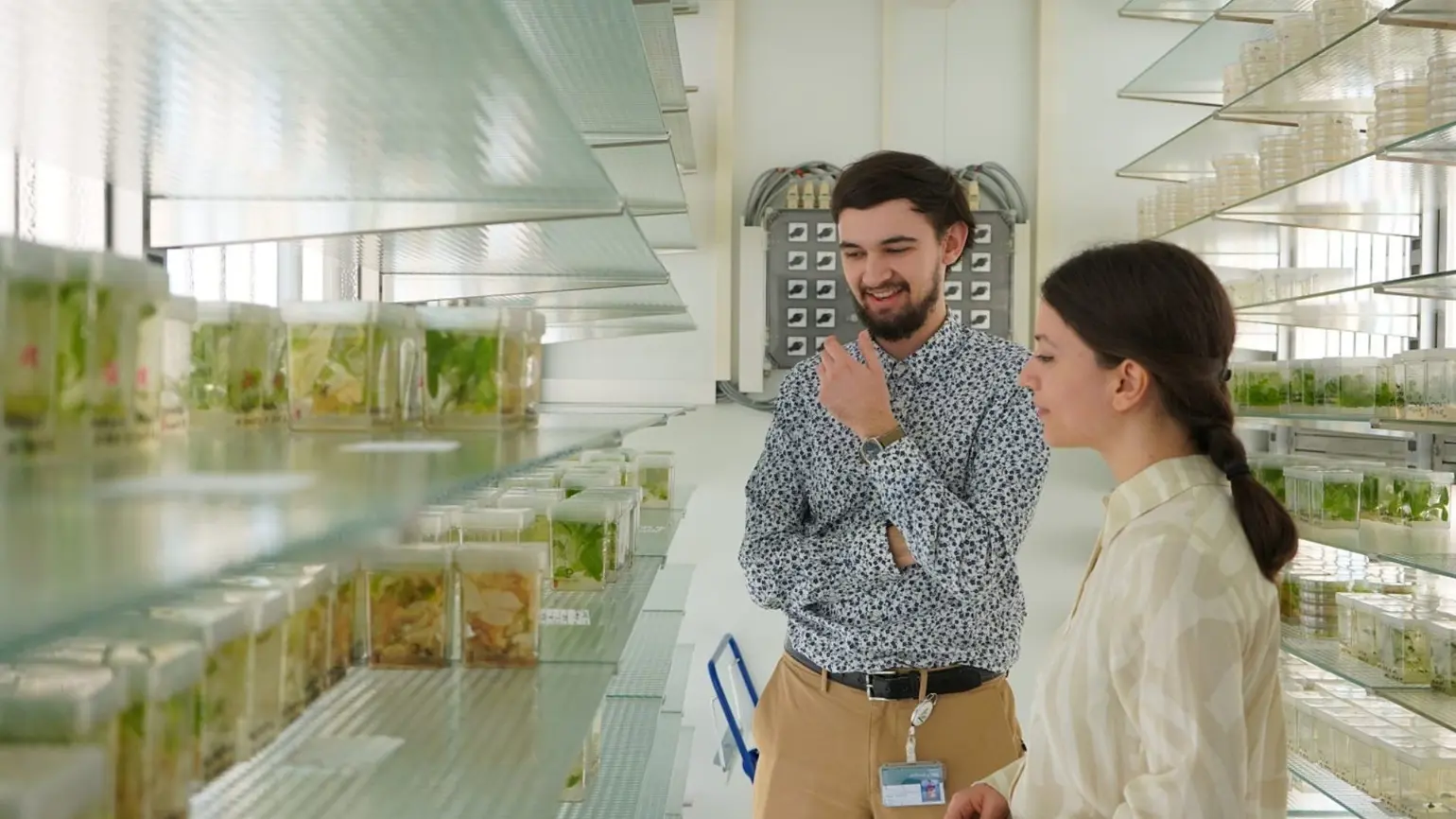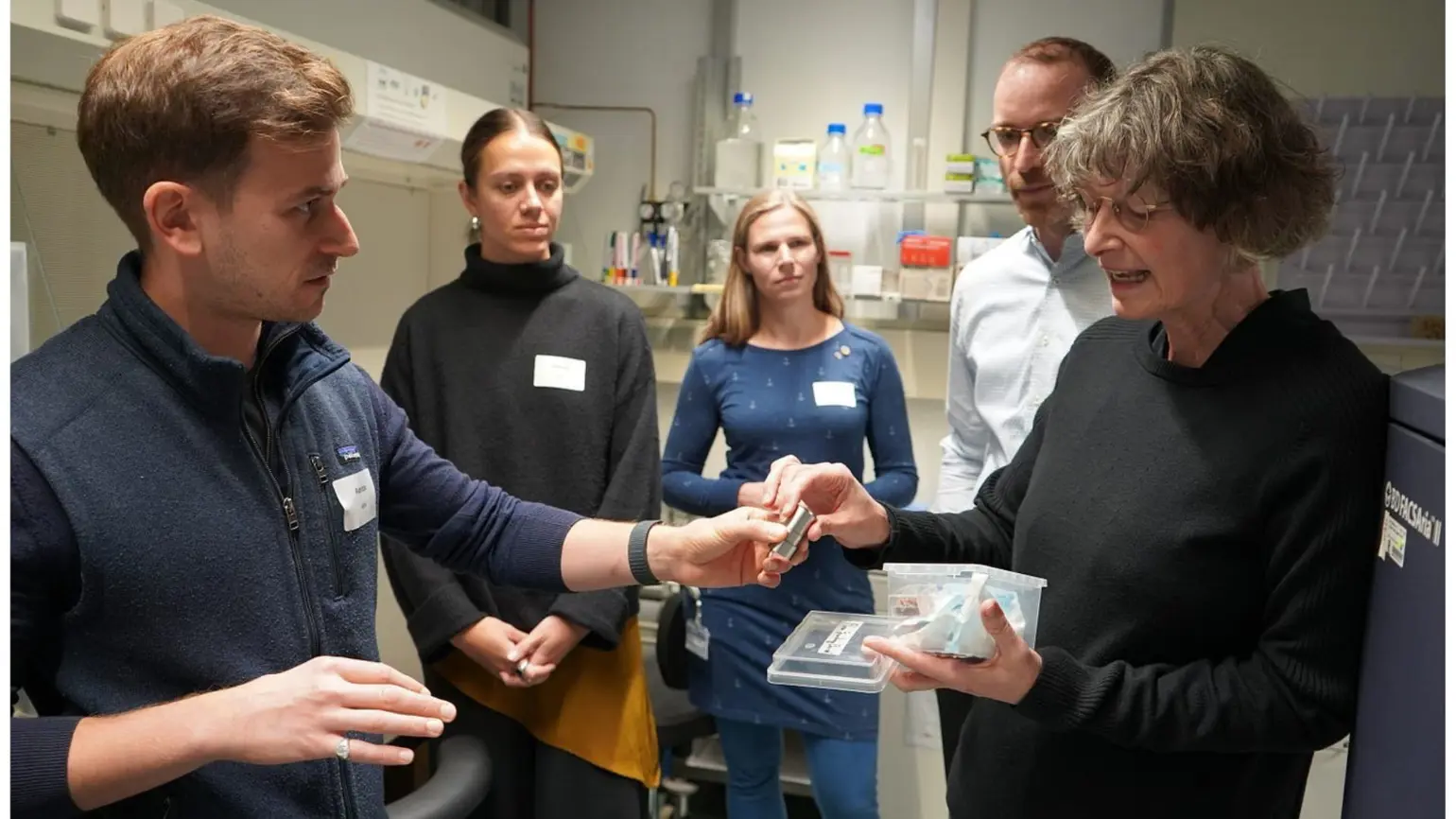30 October 2025
Building synthetic chloroplasts for sustainable crops
Funded as part of our Synthetic Plants programme, we caught up with Daniel Dunkelmann and some of the SyncSol team (Catalina Brown Arancibia, Marianna Boccia, and Mac Flanagan) in Potsdam to see how their research is shaping up.

From left to right: Marianna Boccia, Daniel Dunkelmann, Catalina Brown Arancibia, and Mac Flanagan.
Daniel and his team at the Max Planck Institute of Molecular Plant Physiology are aiming to design, build, deliver and maintain synthetic chloroplasts that are viable in a living plant. The goal is to pave the way for crops that are more productive, resilient, and sustainable.
What are your roles within the team, and how did you all come to work in this field
Daniel: I’m leading the effort here at Max Planck. I fell in love with the lab – the idea that you can think of something, build it, and hold the result. It’s tangible. With plants, your creation can literally grow in a greenhouse.
Catalina: I work as a technical assistant on this project, focusing specifically on plastid transfer, which involves grafting different plant species and ensuring the genetic material moves correctly between them. For me, working in plant synthetic biology is exciting because we have a chance at making a breakthrough that could transform food security, ultimately helping the most vulnerable in society.
Marianna: I’m a postdoctoral researcher working on reducing the size of chloroplast DNA in potato, aiming eventually for genetic code expansion. This would free up the genetic ‘letters’ to encode new, non-natural amino acids and give proteins novel functions. I got into plant science using CRISPR gene editing during my Master’s. Moving into synthetic biology felt like the next step, pushing beyond nature’s boundaries to engineer plants in new ways.
Mac: I’m a PhD student, primarily devising strategies to assemble and select for synthetic chloroplast genomes. Ever since I was a kid, it’s always been plants for me: their biodiversity, genetics, chemistry, it all fascinates me. Synthetic biology adds another layer; it combines so many disciplines, and it feels like the right place and time for making real advances in complex organisms like plants.

A technician working in the greenhouse at the Max Planck Institute of Molecular Plant Physiology.
What are you currently working on?
Daniel: We’re working to generate a universal chloroplast genome, one that’s designed to function across multiple plant species. We’re aiming to incorporate advanced features like genetic code expansion and genetic isolation, which is a bit like creating a firewall between synthetic and natural plants – and these features are only possible through complete synthesis of the chloroplast genome. Our core objectives are speed and scalability; we want to find the fastest model system to build the genome, develop reliable assembly methods, and then efficiently distribute these universal chloroplasts into various crops of major agronomic importance, where they can make a real impact.
We’ve partnered with two leading UK startups, Camena Bioscience and Constructive Bio, to help us overcome the major technical hurdles. The first challenge is in DNA synthesis: chloroplast DNA has characteristics, like being very adenine- and thymine-rich and repetitive, that make many synthesis companies simply refuse the work. Collaborating with Camena Bioscience helps build a strategically vital capability for DNA synthesis within the UK. The second challenge is in assembling these synthesised DNA fragments into the final large genome. Collaborating with Constructive Bio is allowing us to tackle this assembly far faster than we could alone.
What’s the most critical problem you need to solve to get this work off the ground?
Daniel: The biggest challenge is replacing a naturally evolved system with something designed by the human hand, which might initially be less optimised in function: chloroplasts are very good at mixing and matching similar DNA pieces, which we refer to as homologous recombination. Since our synthetic genome needs to perform the same functions, it will inevitably be similar to the native natural one, which could risk the unintended mixing of DNA pieces.
Mac: Imagine trying to build a new jigsaw puzzle, but the pieces keep getting mixed up with a very similar-looking existing puzzle. We need the chloroplast to assemble only our new puzzle.
Marianna: Exactly. We need to figure out how to suppress that mixing and successfully get the cell to adopt our synthetic version over the natural one. Overcoming that is the first major hurdle.

Mac and Marianna observe their plant samples in an incubation room.
If the technology you’re trying to build is successful, what’s the most ambitious application you could imagine for it in ten to fifteen years?
Mac: Customisability. Imagine if farmers could order crops that tailored to their exact needs; they could specify the harvest time, level of disease resistance, and nutrient content. We could have synthetic nuclear and plastid genomes designed for any specific outcome.
Marianna: We could also make plants much more resilient to climate change while also boosting yield. We need crops that can sustain a growing population on a rapidly changing planet.
Catalina: Enhancing food security globally, especially for the communities most vulnerable to climate change. This technology could provide resilient food sources where they’re needed most.
Daniel: Perhaps edible medicines. It’s certainly ambitious, but imagine growing essential medicines directly in plants, bypassing complex manufacturing and distribution chains.

Members of the Max Planck Institute of Molecular Plant Physiology give the ARIA team explanations of specific lab equipment.
What do you wish more people knew about your research area?
Catalina: Let’s look at the current state of play: we know that pesticides are harmful to our health, but if we could create plants that need far fewer pesticides, wouldn’t our food be far more healthy and safe? It’s also crucial to understand that developing the end products takes a very long time, with extensive testing and checks. This rigorous process ensures safety; we aren’t just rushing things from lab to plate.
Mac: Humans have been selectively breeding plants for millennia – synthetic biology just accelerates this process and makes it more precise. Also, its applicability is incredibly broad – it’s a versatile toolkit, not limited to one industry.
Marianna: Exactly. Synthetic biology is a tool to support nature, helping plants adapt to climate change faster than natural evolution allows.
And finally, what book/film/TV show should people check out to understand your project or discipline more?
Catalina: A good analogy comes from the Netflix series Chef’s Table, which has an episode on Blue Hill Farm. They achieve novel results through creative farming – like breeding a new variety of squash for better flavour and nutrition, and including small amounts of red chilli in chicken feed to get red egg yolks. Humans have been safely ‘engineering’ nature for a long time, using creativity to achieve desired traits long before modern synthetic biology. It highlights that editing itself isn’t necessarily inherently risky.
